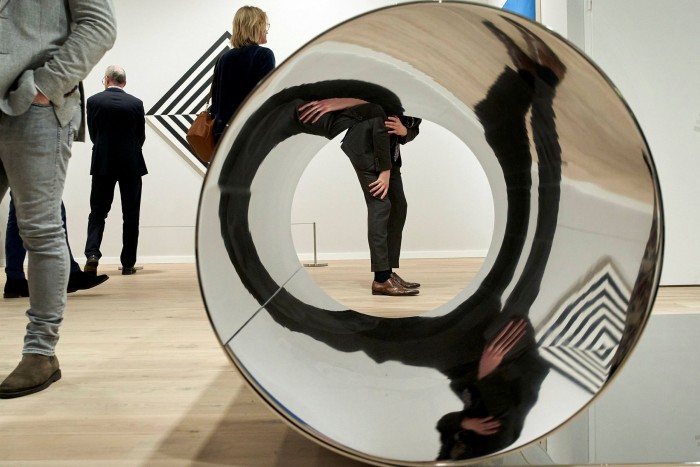How long can the boom in the soaring art market last? Experts are willing to bet on at least another six months as asset appreciation, tech-sector wealth creation and Covid-related stimuli tick over into 2022. “The private equity and venture capital industries can pretty much print money to raise funds,” says Evan Beard, art services executive at Bank of America, “and interest rates are still at near-zero levels. That’s rocket fuel for a non-interest-bearing asset such as art.”
Certainly there doesn’t seem to be much to trouble the auction houses, which have had one of their best years yet, with Sotheby’s and Phillips reporting record high revenues. There are even reports that Sotheby’s owner Patrick Drahi is sounding out a return to the stock market — though it is not commenting.
The auction houses deserve credit for reshaping their business model, as well as capitalising on plentiful cash in the market. They have developed an impressive command of the “hybrid” approach, which combines digital eyeballs around the world with the excitement and energy possible through private views, pre-auction tours and in-person sales.
“We have become ambidextrous, able to push with both hands, or either, as necessary,” says Charles Stewart, chief executive of Sotheby’s. “There’s no need for a contingency plan any more.”
Meanwhile, the 2021 craze for art backed by non-fungible tokens is not going away any time soon, although we can expect more enforcement for them and the wider crypto industry. Two separate markets — one for the more commoditised, entirely digital, collectibles and one for works that emanate from traditional corners — looks to be the shape within the art market of 2022.

Not going away either is the shift to Asia, often thanks to younger, tech-savvy buyers, although where in Asia is up for debate. Hong Kong is at its heart as a financial centre and both Phillips and Christie’s are giving the city a vote of confidence with new Asia-Pacific headquarters, but it is still fragile and other cities will vie for dominance. Seoul is high on the list, with a new Frieze fair to open there in September, while Taipei, Singapore and Shanghai have wind in their sails.
Not that London or broader Europe can take comfort from Hong Kong’s wobble. “Our clients are more interested in selling in New York or Hong Kong just now,” says Guillaume Cerutti, chief executive of Christie’s. “The dollar is so strong and Asia is expanding so quickly.”
While these dynamics are a boon to the wider art market, it will not be smooth sailing for all its participants. Art fairs are still developing contingency plans, despite some happy returns in 2021. The market for older, mixed-category art is the most vulnerable now; the Brafa fair in Brussels has postponed its planned outing in January to June, while Tefaf Maastricht — the most prestigious event in this field — has indefinitely postponed its event in March. This is another blow for the event, which was cut short in 2020 and postponed, then cancelled, in 2021.

Art Basel in Hong Kong will probably run in March, but again as a slimmed-down event — not many expect to travel there. The goodwill to support fairs and comply with ever-moving restrictions might have reached its peak at the end of 2021 — international travel has become too much like hard work.
This, of course, has an impact on galleries, many of which jumped straight back on to the art fair tour as soon as they could but are still weighing their worth. Some are trying a two-pronged approach — opening pop-ups around the world while also showing at fairs — but unless a gallery has limitless funds, this is not a long-term solution.
Others are already taking some of the lessons learnt from the pandemic as a blueprint for a less frantic future. “We had time for pause and to reflect on how being in the gallery and spending time with artists needs to be balanced out with fairs so the scales are rebalanced,” says London dealer Alison Jacques. “And, in our case, we want them to tip towards the gallery rather than the way it was before.” She cites, too, the carbon footprint of such events, something still on the minds of others in the market.
The second half of 2022 is looking shakier. “There will be some sort of economic correction as there is a lot of debt to pay down,” says Ben Clark, chief executive of advisory business Gurr Johns. “The evening sale [top-priced] level won’t be affected but collectors with a bit of spare cash now, who are buying at the $250,000 level, will feel it.”
Such a dynamic — again — would hit the gallery system much more than the auction houses. These bigger players also have the resources to diversify into new business areas, ranging from the metaverse to art lending, another area that will be amplified through 2022 as art is increasingly treated as an asset class. Sotheby’s Charles Stewart remains bullish: “We are questioning everything that we’ve always done and want to drive a little bit faster than everyone else — just not so fast that we crash.” Hold on tight.
Follow @ftweekend on Twitter to find out about our latest stories first
Stay connected with us on social media platform for instant update click here to join our Twitter, & Facebook
We are now on Telegram. Click here to join our channel (@TechiUpdate) and stay updated with the latest Technology headlines.
For all the latest Art-Culture News Click Here
